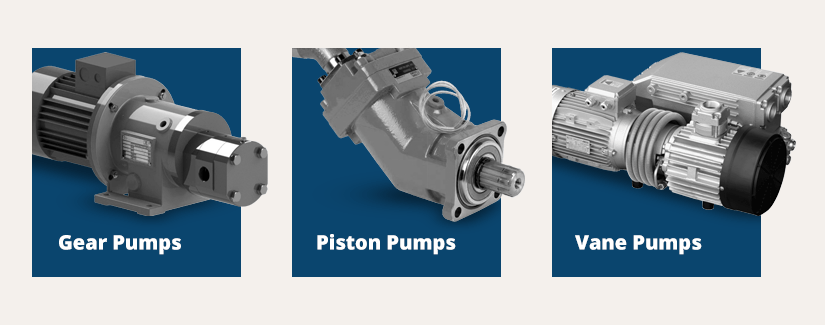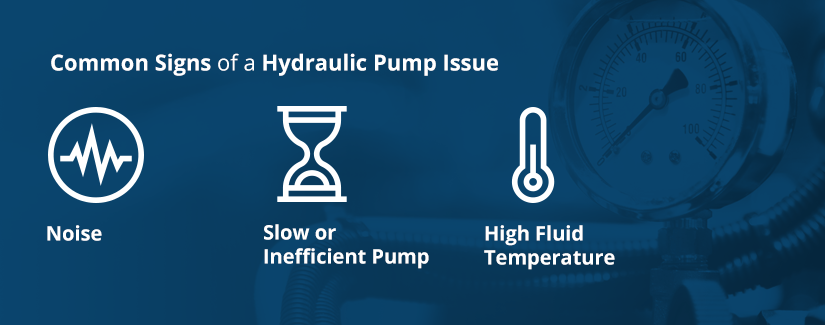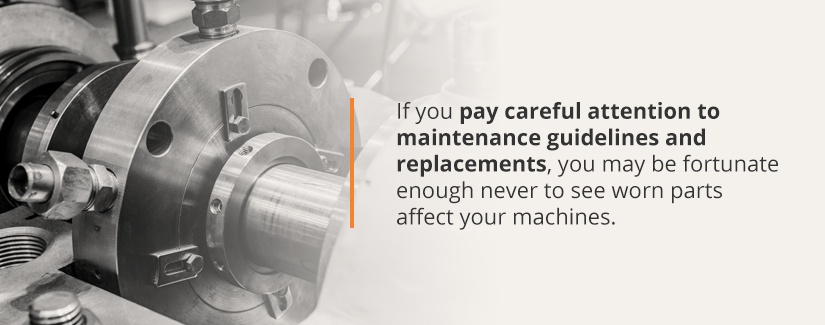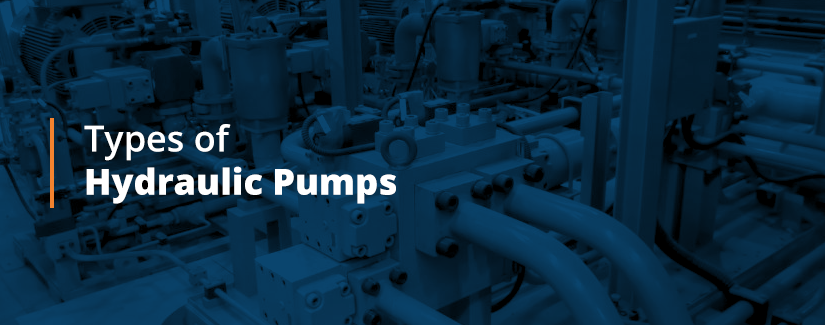Hydraulic pumps are deceptively complex devices required to operate a proper hydraulic system. A displacement pump uses mechanical energy to create hydraulic power. By increasing and decreasing the volume of a container through a series of openings, it manipulates fluid velocity and creates flow.
While some pumps may only have a few moving parts and operate on the foundations of simple machines, they also require precision and can be easily damaged. Pumps continue to become more complex as people find more specialized applications. Moreover, without proper maintenance and upkeep, these pumps can breakdown and cause damage to other components in your hydraulic process.
Because pumps can quickly develop problems, it’s essential to understand the differences between various pumps as well as the signs of trouble. By closely monitoring your hydraulic system, you can prevent small issues from becoming more substantial and costly problems later.
What Are The Different Types of Hydraulic Pumps?

There are many varieties of hydraulic pumps available. For the most part, these options fall under the three types of hydraulic pumps — gear pumps, piston pumps and vane pumps.
Variable displacement pumps allow for alterations in this displacement process, creating a variety of flow options. Fixed displacement pumps, on the other hand, maintain a consistent operating gap.
1. Gear Pumps
These are the most basic hydraulic pump. Gear pumps work by fitting the teeth of two gears together, creating variations in fluid chambers and driving flow. When fluid comes into the intake chamber, the gear teeth make a large opening, allowing plenty of fluid to enter. Then as the gears turn, they shrink the space and displace the fluid, which generates flow. Basic gear pumps operate with two meshed gears, while other pumps alter this format.
Gerotor pumps, for instance, work based on the “gear within a gear” principle. A smaller rotor gear spins inside of a larger idler gear. Fluid enters when the gap between gears is the largest. The rotor moves, space between the idler and rotor gear becomes smaller near the discharge port, displacing the fluid and completing the pumping cycle. These pumps are relatively simple and fast, making them a standard option for low-to-medium pressure pump.
Screw pumps do not necessarily mesh gears together, instead using the principle of an Archimedes screw, which was initially used to move water. The design consists of one or more screws within a cylinder, turned by an external motor. The pump draws in fluid through the intake and fills the gap in the screw. As the shaft rotates, the fluid moves along the path until it reaches the discharge port.
2. Piston Pumps
Piston pumps are the most common and also the most capable of complex jobs. These are the hydraulic pumps you are most likely to find in manufacturing situations. They are the pumps you will use in high-pressure applications. A piston pump is a positive displacement pump that uses a high-pressure seal working reciprocally with a piston to move water. This configuration allows them to operate under high pressure without noticeably affecting flow rate.
Bent axis hydraulic pumps operate similar to piston pumps in that the flow runs through a piston and cylinder process. However, in bent axis hydraulic pumps, the pistons are mounted to a rotating plate, which is in turn attached to a slanted axis. As the rotating plate is at an angle, the displacement in the cylinders increase and decrease depending on where they are in the rotation.
3. Vane Pumps
These are less conventional and more straightforward pumps that you can use for lower-pressure applications with high flow rates. Vane pumps are positive displacement pumps that can work with a number of different vanes, including flexible vanes, swinging vanes, rolling vanes, external vanes and sliding vanes. As the rotor of the motor rotates, the vanes sweep liquid to the opposite side of the cavity inside the motor and squeeze it through discharge holes in the cam.
Common Signs of a Hydraulic Pump Issue

If you have a hydraulic pump, it is critical that you and your employees can recognize the first signs of trouble. Immediate attention will reduce the risk of failure and destruction of your other processes.
Signs that your pump may be experiencing an issue include:
1. Noise
Hydraulic systems themselves, even without any flaws, can create a variety of noises. Learning the normal operating sound of your machinery is vital because a mechanical breakdown will often identify itself through a noise. Each possible malfunction brings a different type of sound. Cavitation, for instance, can produce a growling, while worn bearings might make whining or screeching.
2. Slow or Inefficient Pump
Another indicator that your pump needs maintenance or repairs is noted inefficiency. This may have several causes related to fluid, such as low fluid in the reservoir or a low-viscosity oil. It could also be a sign of wear or even a sign of stuck inner components like pistons or valves.
3. High Fluid Temperature
Although leaks are a more common problem in hydraulic pumps, high fluid temperature can be more vexing to solve. One reason it presents such an issue is that it can be both an indicator of a problem and a cause for other pump breakdowns — for example, a pump may overheat because it is inefficient, but then it may become more inefficient because it overheats. In other cases, an external factor may cause the pump to overheat, but that overheating could then cause wear or leakage.
Because of this, any problems involving an overheating pump should take into account what causes the temperature issue and what attached components may need to be replaced to avoid difficulties with wearing. Aside from the rise in temperature and overheating, high fluid temperatures will likely be seen through an inefficient pump, though it will undoubtedly lead to worn components and possible noise if not rectified.
Common Hydraulic Pump Issues

Those symptoms, while possibly irritating, do not in and of themselves represent a problem. Rather, they’re likely indicating that one or more of these underlying issues are at hand:
1. Fluid Leaks
Leaks are the most common problem that can arise in pump usage. Fluid leaks are often easy to identify. In cases of worn components, gaskets or hoses, you may be able to see the fluid. In other cases, a slow, under-performing pump or continually low fluid reservoir may indicate a leak somewhere along the line.
2. Air in the Hydraulics
In other cases, the problem is that air works its way into the system. The most common symptom will be a weak or slow pump, and in the case of some oils, the fluid will appear milky. If the issue is only small amounts of air initially trapped in the system, your technician may clear the air by running the machine on low speeds for up to an hour. During this operation, it is essential to run the pump on low with little pressure. The goal is to absorb the air into the fluid and allow it to dissipate. It can also be helpful to bleed air from any high release points in the system, leaving only liquid behind. If an air leak is present, you cannot resolve this by running the machine on low as it will likely admit air more quickly than it is removed.
3. Cavitation
Cavitation occurs as small bubbles form in the hydraulic fluid. As the fluid puts pressure on these bubbles, they collapse, which releases a tremendous amount of energy in a hydraulic system. This energy can damage internal components and containers. Often, cavitation will lead to multiple noticeable pump issues, meaning you’ll likely see evidence quickly. Unfortunately, it can also destroy a pump within minutes.
In most cases, cavitation will make a growling sound as the fluid interacts with the vacuum. Moreover, cavitation will often cause the pump temperature to rise, leading to a host of other issues. As the air mixes with the fluid, oil may take on a milky appearance. Finally, the pump will most likely run erratically and inefficiently before failing.
Cavitation may be an indicator that the pump had a design flaw. Otherwise, cleaning filters and ensuring that air does not enter the system are keys to preventing cavitation.
4. Wear
Any mechanical component is subject to wear. If you pay careful attention to maintenance guidelines and replacements, you may be fortunate enough never to see worn parts affect your machines. If you fall a little behind on your upkeep schedule, you may notice that the pump is less effective, as loose couplings or internal parts do not fit as tightly as needed for optimal efficiency.

Beyond poor efficiency, you will often begin to hear the problem as well. When parts become looser, bearings wear out or buffers break down, you may hear an assortment of metal on metal, grinding, rattling, grating or screeching. If the wear has gotten to this point, it’s essential that you stop the pump and contact a professional. Wear only worsens over time, and continued use puts more stress on the attached components, adding unnecessary wear to your other machinery and possibly leading to a more extensive replacement project than if you were to address the initial worn parts.
If you suspect your equipment may be showing signs of wear, some fundamental exterior aspects you’ll need to examine are slackened connections and coupling or loose set screws. If these external components are fine, your technician may examine the pump for worn bushings or other overworked internal parts.
5. High Pump Temperatures
As mentioned before, pump temperature is an indication that something is wrong as well as a cause for other issues. One cause of high temperature may be an improper heat load. All machines run with some form of energy loss. The heat load is determined by calculating how much input power is lost to inefficiency, resulting in heat energy. If the pump is running too inefficiently or the power input is too great, the excess energy becomes heat.
Another possible consideration is fluid viscosity — using a lower-viscosity fluid may cause the pump to create excess heat. As with most issues involving fluid temperature, this is a cyclical problem, since the lower-viscosity fluid overheats the pump, which will cause the fluid to break down more quickly and lower the viscosity even further. Finally, cavitation may be another cause of an overheated pump. When a piston pump cannot get a full draw or otherwise mixes air into the fluid, the pump can run erratically. Aside from being noisy and inefficient, the pump will often overheat.
6. Stuck Internal Components
Internal mechanisms can seize up inside of the pump, causing noises and inefficiency. Pistons, veins and other pump pieces can become difficult to move, sometimes making the pump fail to operate at all. Identifying the seized part might also give insight into the possible cause. For instance, rusted components indicate that water is finding a way into the system, while a hardened, varnish-like residue can suggest that the pump is operating at too high of a temperature.
How to Troubleshoot Hydraulic Pump Issues
Troubleshooting a pump can be challenging. While knowing common problems and symptoms can be helpful, it is easy to damage the equipment or cause employee injuries through improper adjustments. Cavitation can quickly destroy your entire system. Moreover, as seen in the case of pump temperature, issues can be multi-faceted, leading you to believe you’ve addressed a pump problem only to find out it was just one part of a larger chain.
Still, a maintenance member on your staff may be able to check for preliminary problems, ruling out or adjusting some of the most common issues. Moreover, unclean working environments create intake clogs and a host of other pump problems. Properly purifying valves and filters can both fix current issues and reduce the risk of future breakdowns.
Some common troubleshooting steps:
- Examine any visible connection points for possible fluid leakage.
- Become aware of the proper sounds of your equipment before a problem, then listen for any variations. Note the location and nature of the sound.
- Check all mounting screws and hose attachments to be sure all external sources are connected and tight.
- Check fluid levels and examine physical appearance, noting if the color or viscosity seems incorrect.
- Understand the signs of cavitation and check individually for related issues.
If at any point you are unsure about your hydraulic system, contact a professional to examine your equipment.
GES Hydraulic Repair Process
Although familiarity with all of the different types of pumps is a requirement for all of our trained technicians and facilitates the repair process, the problems that hydraulic pump issues face and the way we resolve them is relatively similar for all types of hydraulic pumps.
The Global Electronic Services hydraulic repair process starts by fully disassembling the hydraulic pump so we can see each part to visually identify what is causing the problem. Once we find what is creating the issue, we will repair it if possible. If not, we’ll replace it with a new OEM part. We will then reassemble the pump and test it to make sure it is operating according to original specifications.
We will replace any worn-out parts with new ones so that when you get your hydraulic pump back, it will be like-new. To ensure your confidence in our repair, we offer our 18-month in-service warranty.
In addition to our promise that you will get back a fully functioning hydraulic pump — usually in five days or less from the time we receive it — you will also appreciate that we have the lowest price anywhere when it comes to hydraulic pump repair. If you can bring us a verified competitor’s price for hydraulic pump repair that is lower than ours, we will beat it by 10 percent.
Let Us Solve All Your Hydraulic Pump and Other Mechanical Part Repair Problems Today

If you’re having a problem with your hydraulic pumps, you don’t want to waste a minute. Your hydraulic pumps are a critical part of your operation and every hour you spend without a necessary pump could cost you valuable productivity and hurt your bottom line. At Global Electronic Services, our goal is to minimize that downtime by turning around your hydraulic pumps and other mechanical parts in need of repair as fast as possible.
Contact us now to request a free, fair and accurate quote on hydraulic pump repair and have your pumps back and in top working order in the shortest possible time at the lowest possible price. Get in touch with Global Electronic Services today!
